Now that we understand how to size a battery to charge our laptops, I’d like to tell you about the two I’ve been testing: the Jackery PowerBar with a capacity of 77Wh/20800mAh and the RAVPower Power Station (RP-PB055) with a capacity of 99.5Wh/27000mAh.
Both batteries are designed to charge your smaller mobile devices via USB-A and USB-C but also sport AC outlets for charging laptops. Both of these batteries have excellent specs and I can highly recommend, but they have different advantages and disadvantages. Both batteries cost $130 on Amazon so I think this is a valuable comparison. These are not the only batteries out there for charging laptops but they’re the only two I’ve tested personally.
For brevity, I’ll be calling the batteries by their manufacturer’s name only, rather than their full product names.
Form Factor
Jackery Form Factor
 The Jackery was described by The Wirecutter as being the size of a pint glass. When it arrived, I photographed it next to a Ballast Point Black Marlin pint glass. They’re right, it’s just about the same size. The Jackery is 6.25″ long with a rounded square cross section of 2.5″. It’s a nice gunmetal grey.
The Jackery was described by The Wirecutter as being the size of a pint glass. When it arrived, I photographed it next to a Ballast Point Black Marlin pint glass. They’re right, it’s just about the same size. The Jackery is 6.25″ long with a rounded square cross section of 2.5″. It’s a nice gunmetal grey.
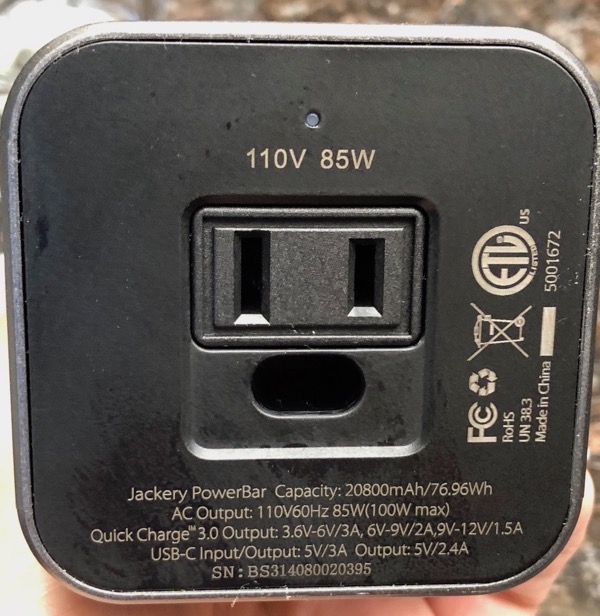 On one end it has the AC outlet and a light to indicate whether the 110V power delivery is enabled. They made a design decision to put the power button on the opposite end to enable the AC port, which makes it a little clumsier than I would have liked to make sure you’re delivering power. In general, I still depend on my Mac anyway to tell me with that happy little “ding” when it’s being charged.
On one end it has the AC outlet and a light to indicate whether the 110V power delivery is enabled. They made a design decision to put the power button on the opposite end to enable the AC port, which makes it a little clumsier than I would have liked to make sure you’re delivering power. In general, I still depend on my Mac anyway to tell me with that happy little “ding” when it’s being charged.
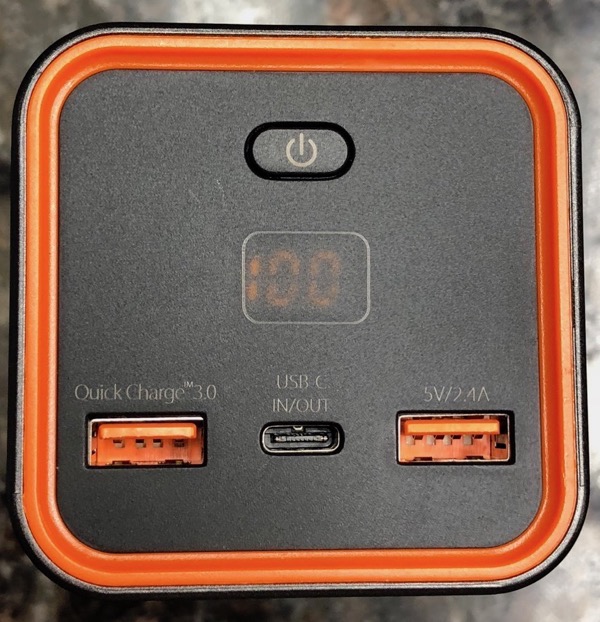 On the other end, it has two USB-A ports. If you have a device that supports QuickCharge 3.0, one of the two USB-A ports will take care of you there and the other will give you 5V at 2.4A, which is the requirement to charge a 12.9″ iPad Pro or smaller. On this same end with the USB ports and the power switch, there’s an LED which shows you the charge level of the battery. In my tests, the battery level seemed to provide accurate information as I drained it.
On the other end, it has two USB-A ports. If you have a device that supports QuickCharge 3.0, one of the two USB-A ports will take care of you there and the other will give you 5V at 2.4A, which is the requirement to charge a 12.9″ iPad Pro or smaller. On this same end with the USB ports and the power switch, there’s an LED which shows you the charge level of the battery. In my tests, the battery level seemed to provide accurate information as I drained it.
The silk screening on the USB end of the Jackery could be improved. Even with a bright light, it’s thin enough to be difficult to read. I relied on some photos I took under bring lighting conditions to be sure I could read the text. Luckily on the AC outlet end, all of the specs are clearly printed.
The Jackery charges with a USB-C wall adapter, which uses the input/output USB-C port previously described. I tried charging it with my USB-C wall adapter for my MacBook Pro and it didn’t charge, which means you do have to keep track of Jackery’s wall adapter. I like that it’s very small and the cable was a reasonable length which was nice.
When I handed the Jackery to people at Macstock Expo, everyone said that it wasn’t as heavy as they expected. It’s not light at 1.5lbs, but since it has an internal fan for cooling when converting to AC power, it’s much less dense than we are used to with traditional USB batteries.
RAVPower Form Factor
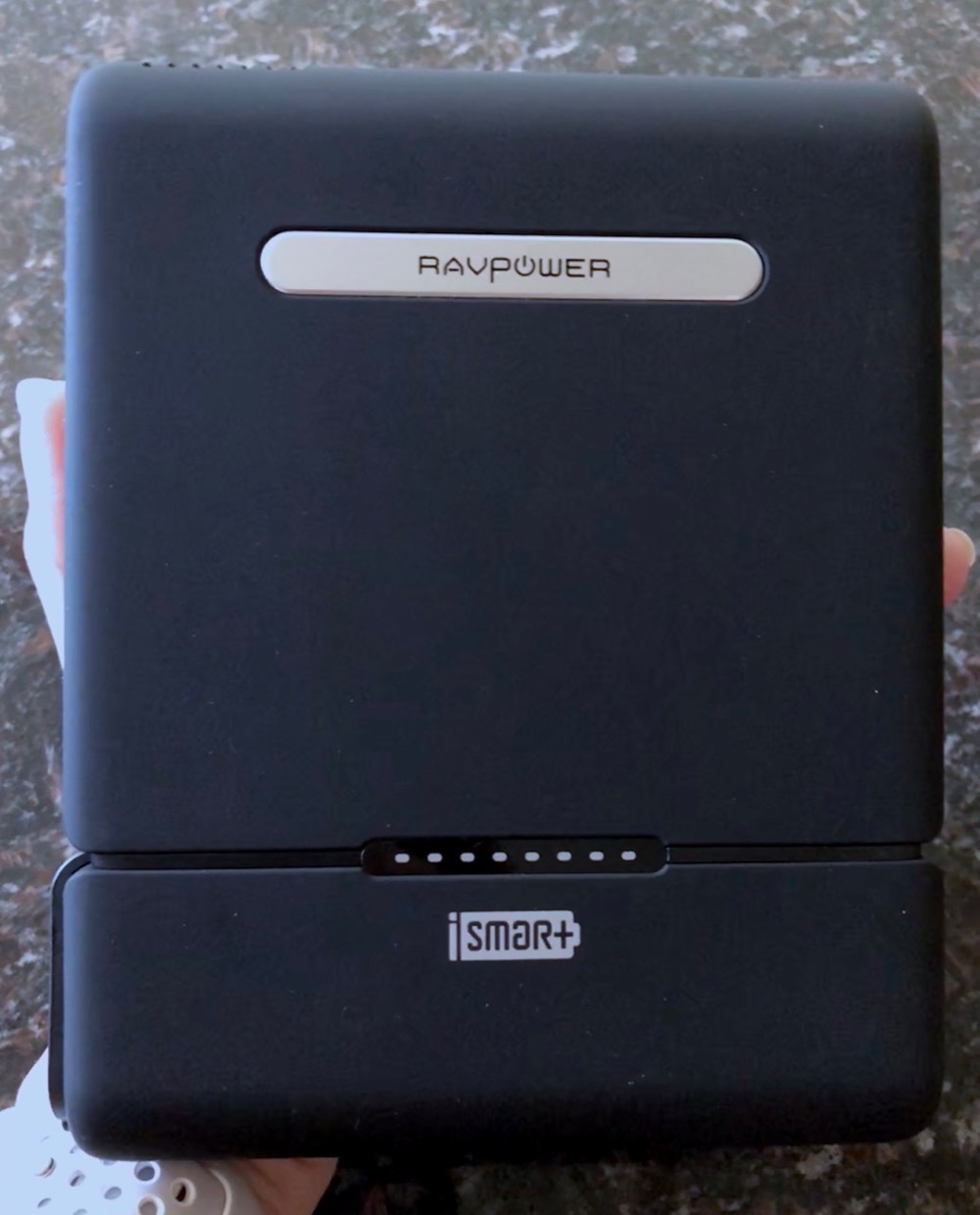 The RAVPower is similar in size to a thick paperback book at 5.5 x 7 x 1.25 inches thick. It has that lovely black sort of velvety coating that makes it feel nice in the hand. The corners are also rounded to make it feel a bit sleeker. But this 99.5Wh battery weighs in at 1.87lbs, so 25% heavier than the 77Wh Jackery. If you have a larger laptop, you’re going to need the RAVPower but if you’ve got a smaller laptop and can get away with the Jackery it might be a better choice based on weight alone. Let’s not make a call based just on that, but it’s something to keep in the back of your mind when choosing.
The RAVPower is similar in size to a thick paperback book at 5.5 x 7 x 1.25 inches thick. It has that lovely black sort of velvety coating that makes it feel nice in the hand. The corners are also rounded to make it feel a bit sleeker. But this 99.5Wh battery weighs in at 1.87lbs, so 25% heavier than the 77Wh Jackery. If you have a larger laptop, you’re going to need the RAVPower but if you’ve got a smaller laptop and can get away with the Jackery it might be a better choice based on weight alone. Let’s not make a call based just on that, but it’s something to keep in the back of your mind when choosing.
On one of the long sides, you’ll see the AC port, a power switch, two “iSmart” USB Output ports along with a 3A USB-C Output port. The iSmart ports both work at 5V 2.4A. RAVPower’s iSmart branding is described on their site as “intelligently detects the charging needs connected devices and automatically delivers the output needed for complete efficiency.” That’s good stuff, but different from QuickCharge on the Jackery.
 Like the Jackery, the RAVPower also includes an internal fan which kicks in quickly when charging your laptop via AC. The RAVPower doesn’t charge over USB. It has one of the old-school power supplies with a power block partway along the power cable and the cable pulls out of it so it’s easy to store. It’s probably the only thing I don’t like about the RAVPower. The power supply is bigger and heavier than the Jackery USB-C charger block.
Like the Jackery, the RAVPower also includes an internal fan which kicks in quickly when charging your laptop via AC. The RAVPower doesn’t charge over USB. It has one of the old-school power supplies with a power block partway along the power cable and the cable pulls out of it so it’s easy to store. It’s probably the only thing I don’t like about the RAVPower. The power supply is bigger and heavier than the Jackery USB-C charger block.
However, the Jackery, though a smaller battery, takes 7 hours to charge. In contrast, the much larger capacity RAVPower takes 5.2 hours to charge. The reason the Jackery takes longer gets back to the things we learned in the lesson about electronics. In looking at the two power supplies, the Jackery USB-C charger says 100-240V at .45A while the more traditional DC power supply for the RAVPower says 110-240V at 0.9A.
We know volts x amps = watts of power, so if both adapters are getting the same voltage from the wall port, the RAVPower charger supplies power at exactly twice the rate of the Jackery. So maybe I don’t hate RAVPower’s DC power supply quite as much now.
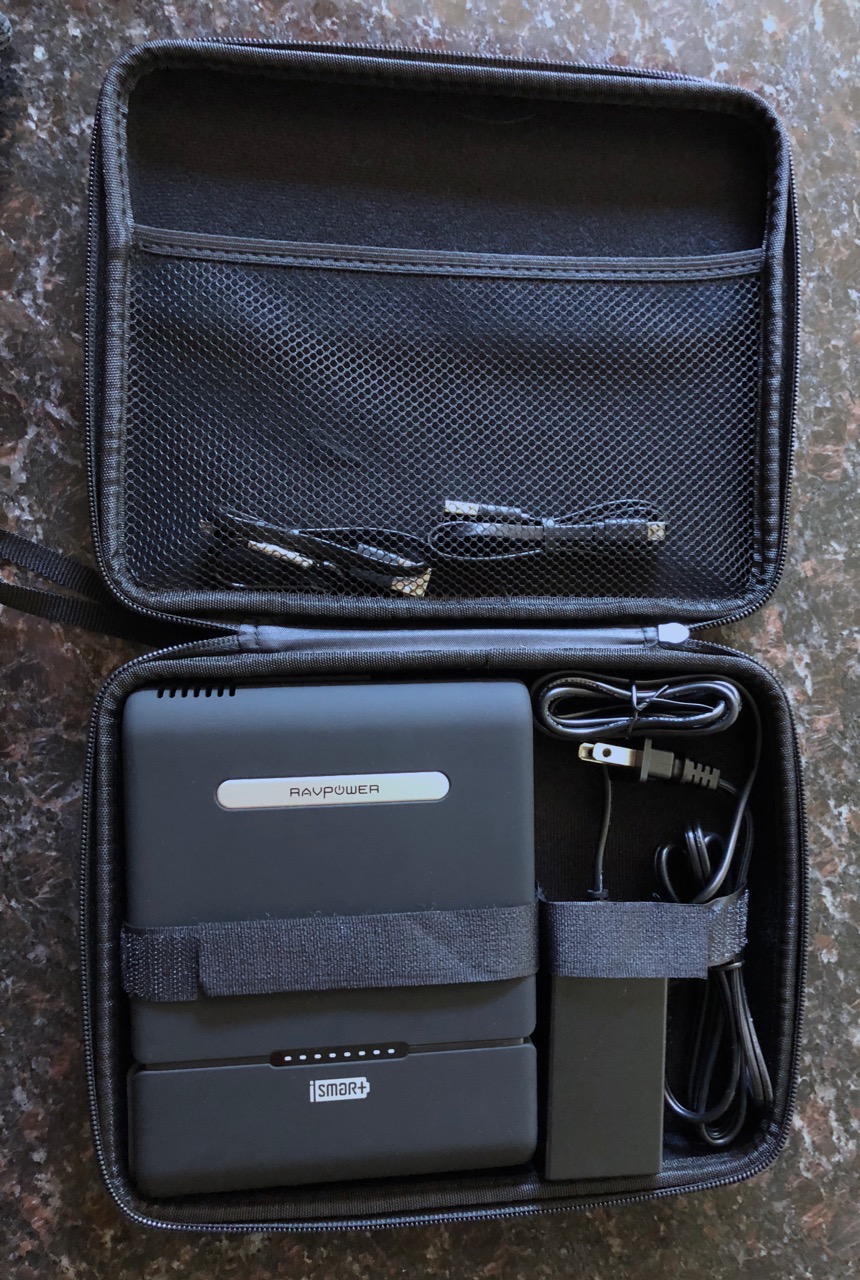 If charge speed is important to you, then the RAVPower charging 25% faster might be a factor in your decision. But if you plan on charging the battery overnight, perhaps this isn’t a critical decision point.
If charge speed is important to you, then the RAVPower charging 25% faster might be a factor in your decision. But if you plan on charging the battery overnight, perhaps this isn’t a critical decision point.
I mentioned that the Jackery has an LED numerical readout of the charge level of the battery. The RAVPower has 8 LEDs to indicate charge level. In normal usage, having a precise value for the charge level isn’t all that important so the 8 LEDs is fine. However, in my testing, the number of LEDs went down precipitously, long before the battery was actually running out. I’ll get into the details of that when I get to the charging section of this article. I don’t know if my LEDs are malfunctioning or whether this is normal behavior for the RAVPower.
The RAVPower comes with a really nice, hard-shell case to carry the battery, the charger, and the two included micro-USB cables. The battery and charger strap into place, with a pocket for other accessories. But they also include a cushiony mesh bag made for carrying the battery alone in your bag. It’s a nice touch as I’d hate to see the lovely finish of this get marred banging around in my backpack.
But How Well Do They Charge?
In the post where we explored the math on how to determine if a battery could charge your laptop, I included a chart showing the predicted charge capability of the Jackery and RAVPower batteries vs. the latest (2018) versions of the 12″ MacBook and the 13″ & 15″ MacBooks Pro. Armed with this information, it was time to see whether the theory matched with real-life testing. My MacBook Pro and Steve’s are 2016 models, and they both have slightly smaller capacity batteries than the newer models. This is why I said to look for your exact battery capacity before deciding which battery is right for you.
Jackery PowerBar Charging
The Jackery PowerBar, as you may recall is a 77Wh battery so if we remove the inefficiencies (calculated by multiplying 77Wh by 72%) it should be able to deliver 55.4Wh of charge. My 2016 15″ MacBook Pro has a 77Wh battery, so the Jackery should be able to charge it to 55.4/77 = 72%. I did a few tests while using the 15″ MacBook Pro and charging at the same time, and a few partial tests with the 15″ asleep, and the Jackery just didn’t have enough capacity to keep up. That’s not a problem with the battery, it’s just the wrong battery for my Big Girl MacBook Pro.
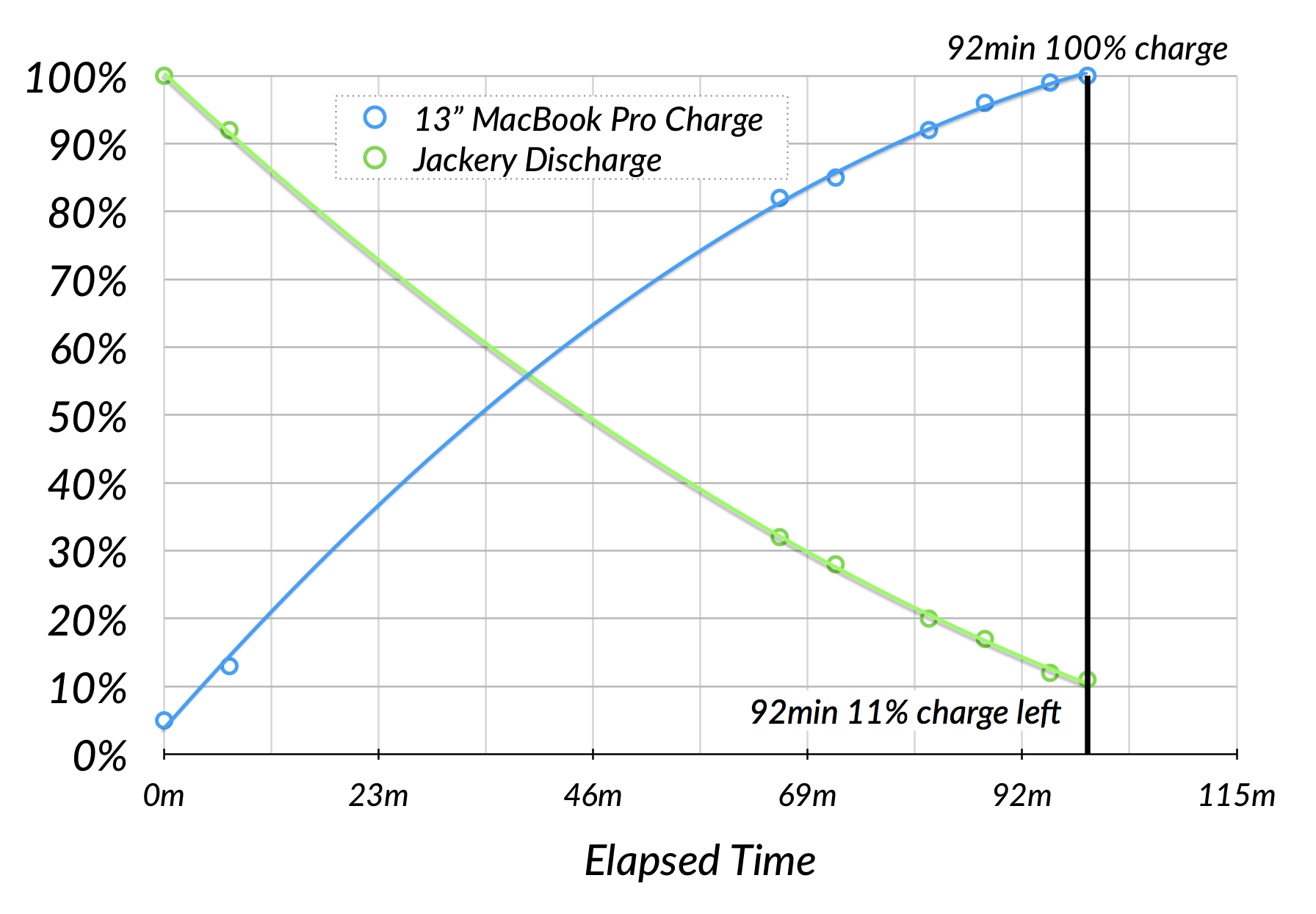 Steve’s 13″ MacBook Pro is the 2016 model with 4 Thunderbolt 3 ports, and according to Apple’s tech specs has a battery capacity of 49.2Wh. 55.4/49.2 = 113%. That says I should be able to fully charge his Mac and have 13% left over on the Jackery.
Steve’s 13″ MacBook Pro is the 2016 model with 4 Thunderbolt 3 ports, and according to Apple’s tech specs has a battery capacity of 49.2Wh. 55.4/49.2 = 113%. That says I should be able to fully charge his Mac and have 13% left over on the Jackery.
I drained Steve’s 13″ MacBook Pro until it completely died (which is around 5%) and then charged it with the Jackery starting at 100%. In 92 minutes, the MacBook Pro went from 5% to 100%, and the Jackery was left with a whopping 11% left. This extra 11% allowed me to charge a completely dead iPhone 8+ up to 90% before the Jackery asked for mercy and shut down.
That’s astonishing in my book. Even though this isn’t the right battery for me, I think it’s a fantastic choice for a 13″ MacBook Pro.
RAVPower Charging
Now let’s take a look at the tests on the RAVPower with my Big Girl 15″ MacBook Pro. According to Apple’s knowledge base article, the 2016 15″ MacBook Pro has a 76Wh battery.
I ran two tests on the RAVPower, one charging the 15″ MacBook Pro from near zero while I was using it, and one while the MacBook Pro was closed and asleep. The RAVPower absolutely met its promise. With a 99.5Wh battery, at 72% efficiency, it should be able to deliver around 72Wh of charge. With my 76Wh MacBook Pro, I should have been able to charge it to 72Wh/76Wh = 95%.
But the RAVPower outperformed my expectations. With the Mac asleep while charging, it went from 5% to 100% in 114 minutes. Again remember the efficiency numbers are rough estimates, and could easily vary between the Jackery and the RAVPower.
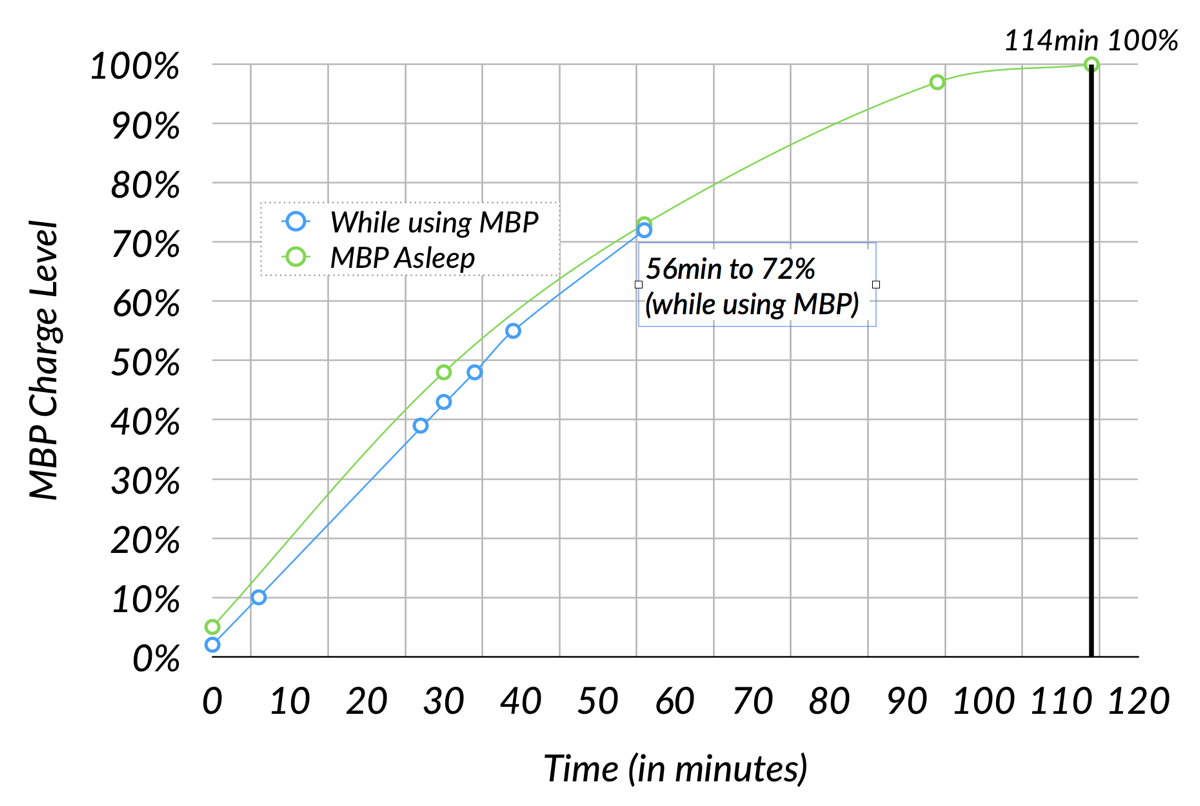 I also tested charging my 15″ MacBook Pro while charging from the RAVPower which is probably how I would intend to use it. I’ve been stuck on a plane with a dead Mac (plane outlets don’t deliver enough power for the 15″) and I’m often in conferences where my Mac runs out. In my test, the 15″ MacBook Pro while in use charged from 2% up to 72% in 56 minutes before the RAVPower was out of juice. That’s really pretty impressive considering I had my screen at full brightness with WiFi and Bluetooth both enabled. Knowing I can get a three-quarters charge in less than an hour from fully dead while using my Mac is amazing.
I also tested charging my 15″ MacBook Pro while charging from the RAVPower which is probably how I would intend to use it. I’ve been stuck on a plane with a dead Mac (plane outlets don’t deliver enough power for the 15″) and I’m often in conferences where my Mac runs out. In my test, the 15″ MacBook Pro while in use charged from 2% up to 72% in 56 minutes before the RAVPower was out of juice. That’s really pretty impressive considering I had my screen at full brightness with WiFi and Bluetooth both enabled. Knowing I can get a three-quarters charge in less than an hour from fully dead while using my Mac is amazing.
I recorded a few data points along the way (with the help of my awesome housekeeper Rocio who checked in on my laptop while it was charging). I’ve included both sets of charging data, (Mac asleep and awake) on the same graph. I did that because I discovered something really interesting. The rate of charge (percentage gained on the Mac per minute) was nearly identical. That means the RAVPower actually stepped up the rate it was delivering to compensate for the fact that the Mac was draining faster by being used at the time. I thought that was pretty interesting.
I did check the TSA Lithium Ion carry-on battery maximum size, and it’s 100Wh, so the RAVPower at 99.5Wh is obviously sized to just be legal for carry-on luggage.
Customer Service
I don’t want to close out this review without talking about customer service. I only asked RAVPower one question and Kaye came back with an answer. I asked Jackery a TON of questions and Ian and I became pals along the way as a result. Much of the information in my article about figuring out what battery you need came from Ian.
He’s the one who explained that the power conversion loses 20% and converting from the Mac’s power adapter loses another 10%. He’s the one who helped me with the initial understanding that you can’t charge a MacBook Pro through the USB-C port. That discussion helped inform Steve and my path to the full understanding of why. Ian was awesome. He offered to let me return the Jackery PowerBar because it wasn’t right for my use, but I decided their support was so awesome that I would give it away to our friend Pat Dengler who has the 13″ MacBook Pro.
Like I said, RAVPower answered the only question I asked so this isn’t any kind of criticism against them, just that Jackery was really put to the test. I did read in the RAVPower comments on Amazon that a few people had units that didn’t work properly, and they changed their reviews from 1 star to 4 or 5 stars because RAVPower saw their comment, got them new units quickly, and the replacements performed as expected. So RAVPower gets good marks in customer service too.
Bottom Line
If you’ve got a 13″ MacBook Pro or smaller, and you can wait 7 hours for a full recharge of your external battery, the lighter Jackery PowerBar is probably the one for you to get. I initially found the Jackery Power Bar through the review by the Wirecutter: The Best Portable AC Battery Pack. They do a lot more testing than I do, so it’s well worth a read.
If you’ve got a bigger Mac or want to be able to charge many things many times say while camping, the RAVPower will meet those needs.
I’m just happy that these solutions finally exist and from two companies who are taking good care of their customers. If you’ve done rigorous, real-world testing on batteries for laptops with AC charging, I’d sure like to hear your results too.
